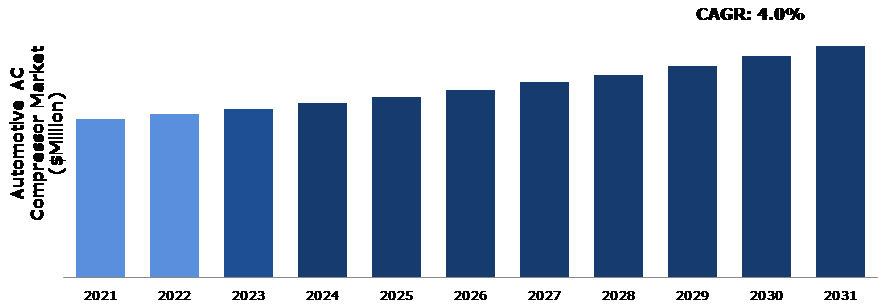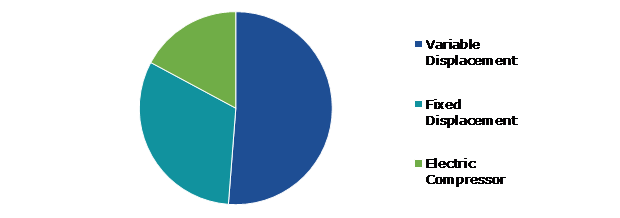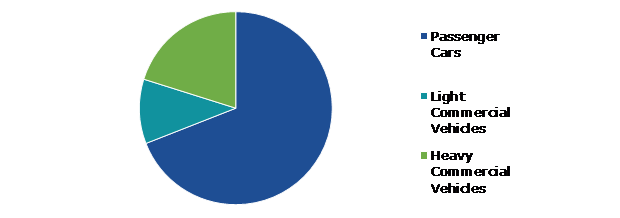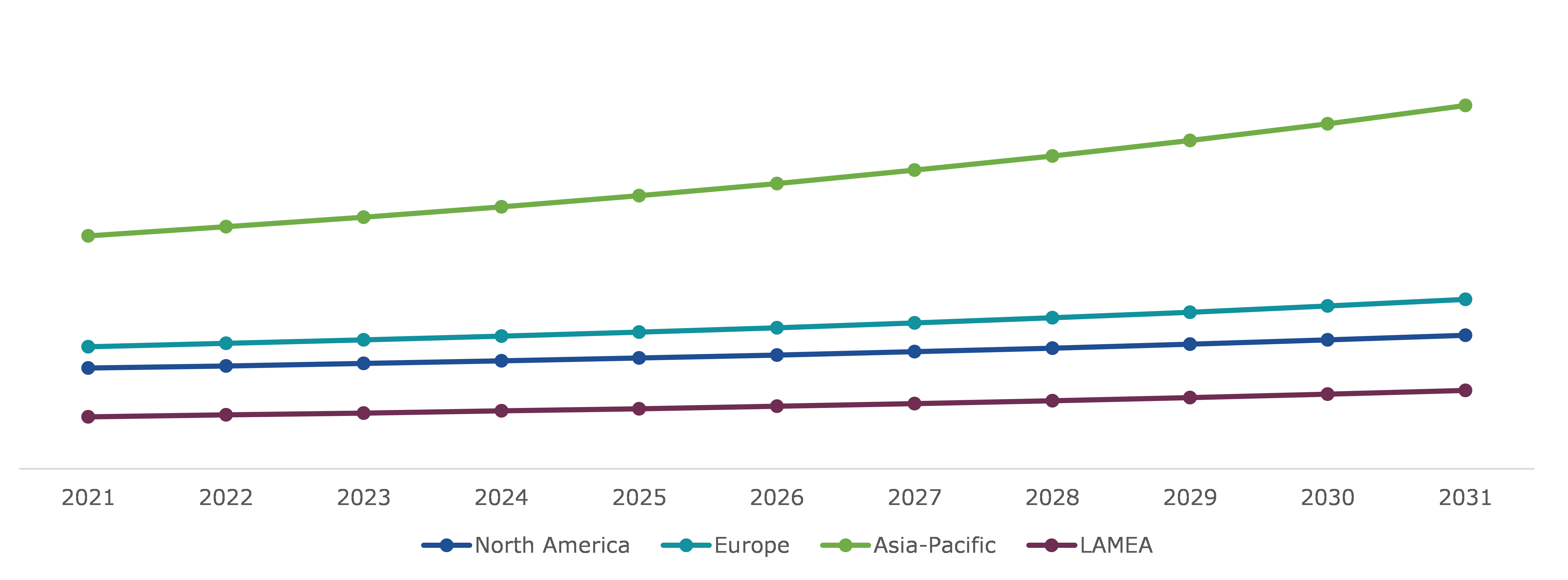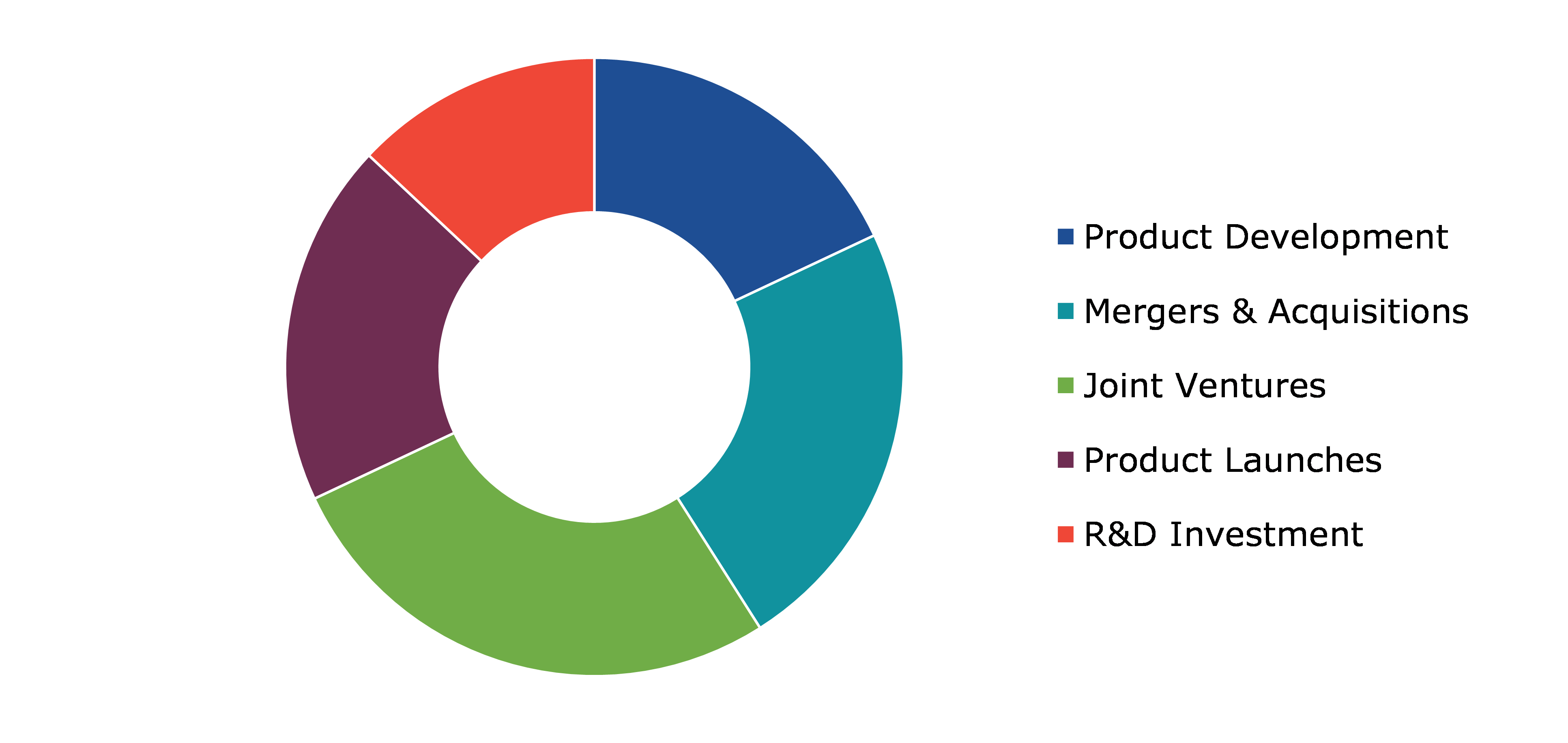Automotive AC Compressor Market Report
RA08613
Automotive AC Compressor Market by Compressor Type (Variable Displacement, Fixed Displacement, and Electric Compressor), Vehicle Type (Passenger Cars, Light Commercial Vehicles, and Heavy Commercial Vehicles), Drive Type (Electric and Conventional), Sales Channel (OEM and Aftermarket), and Regional Analysis (North America, Europe, Asia-Pacific, and LAMEA): Global Opportunity Analysis and Industry Forecast, 2022-2031
Global Automotive AC Compressor Market Analysis
The Global Automotive AC Compressor Market Size was $8,045.5 million in 2021 and is predicted to grow with a CAGR of 4.0%, by generating revenue of $11,794.2 million by 2031.
Global Automotive AC Compressor Market Synopsis
The increase in manufacturing of vehicles in several countries is a significant factor driving the automotive AC compressors market growth. As the demand for comfort features in vehicles increases and four-wheeler vehicles increasingly use automotive AC compressor systems. Additionally, technical developments in terms of efficiency and performance have made automotive AC compressors systems more affordable, promoting their acceptance in the vehicle industry. The aforementioned factors are projected to support the growth of the automotive AC compressor market during the forecast period. Environmental restrictions are a useful tool for enhancing the quality of AC, and vehicle designers are constantly looking for ways to raise cost-effectiveness. The AC compressor is used to compress the AC unit and maintain R134a flowing for it to function effectively. Thus, rising vehicle sales and shifting customer expectations are anticipated to drive the global automotive AC compressor market.
Refrigerants are potent greenhouse gases (in the liquid form), and their leakage has a strong adverse impact on the climate and the environment at large. As refrigerants are essential for blower operation, several state-run administrations across the world have set guidelines to prevent contamination caused by these refrigerants. The strict application of these laws may act as a hindrance to the growth of the car climate control system blower sector. Furthermore, the use of low-quality refrigerants and the associated leakage concerns may have an unfavorable impact on the market development. Regardless, automakers are attempting to alleviate such concerns by incorporating complex and cutting-edge technology into cooling frameworks.
Increase in automotive production and automobile ownership, as well as customer demand for vehicle comfort, are projected to drive the growth of the automotive AC compressor market. Furthermore, increase in automotive manufacturing in numerous countries is an essential factor expected to drive the market growth. The cost of air conditioning systems has increased due to higher technical advancements in terms of performance and efficiency. These factors are expected to create opportunity in the automotive AC compressor market during the forecast period. Global warming has caused the temperatures to rise in the recent years, skyrocketing the requirement for air conditioners. Furthermore, the disposable income of the people in developing countries is increasing. These reasons are projected to increase the opportunity in the automotive AC compressor market.
According to regional analysis, the Asia-Pacific automotive AC compressor market accounted a dominating market share in 2021 and it is anticipated to show the fastest growth by 2031. The Asia pacific automakers are increasing their production to cater to the local as well as export demand of vehicles, which, in turn, is fueling the automotive AC compressor market in Asia Pacific.
Automotive AC Compressor Market Overview
The introduction of new electrically powered AC compressors has facilitated the integration of AC systems in vehicles by reducing the load on engines and allowing remote operation of the vehicle's AC. This makes sure that the temperature is already set to the desired comfort level when people board the vehicle. The demand for these innovative automotive AC compressors is expected to rise in the forecast period.
COVID-19 Impact on Global Automotive AC Compressor Market
The automotive industry has been severely hit due to the COVID-19 pandemic. The forced implementation of lockdowns by various governments had a grave influence on car production and sales. The automobile sector is anticipated to fully recover and resume normal commercial operations in 2024. Such possibilities create obstacles for those participating in the automobile AC compressors market. Fueling the global industry's progressive expansion, players in the automotive AC compressor market are adopting the plug and play mode to adapt to slow growth in the overall industry. Car manufacturers are focusing more on electric cars (EVs) as a consequence of the erratic demand and supply, which has emerged from customers' increased awareness of their spending and demand for long-term investments to purchase a variety of goods and commodities. The coronavirus pandemic hampered the market growth, resulting in a drop in passenger car sales. Misleading claims that COVID-19 spreads through automotive air systems have severely affected the cooling industry, slamming the whole industry. Manufacturing companies are using the Internet to spread the word about false claims, but the influence of virus has led customers to believe in fake news and misinformation in such circumstances.
The Rise in Disposable Income Worldwide to Drive the Market Growth
Customers are concerned with the car's accessories, safety, ride comfort, and other similar features while buying a new vehicle. The inside temperature of a car has a significant impact on the riding experience and driver comfort. Optimal cabin temperatures prevent exhaustion while driving, lowering the likelihood of an accident, and therefore increasing safety. AC systems have become common machinery in the majority of vehicles manufactured worldwide due to these advantages. On 15 December 2017, Hanon System stated that it has signed an investment agreement with the Chinese government of Dalian Municipality to develop its operations for automotive compressors in order to promote business growth in the country.
To know more about global automotive AC compressor market drivers, get in touch with our analysts here.
Strict Enforcement of Refrigerant Rules is Projected to Significantly Hamper the Market Growth
Refrigerants are essential for compressor operation, yet their leakage has a significant negative impact on the customer and the environment. Luxury car pricing is also expected to act as a limitation for the automotive AC compressor industry, increasing the high cost of AC systems installed in luxury automobiles. The design, fabrication, and assembly of an AC compressor needs extreme accuracy, superior R&D facilities, and cutting-edge technology. Furthermore, it necessitates technical skill as well as significant expenditure. Advances in materials, components, and systems raise the cost of an AC compressor in comparison to other types of compressors.. Maintenance concerns, technological constraints, and the high pricing of luxury automobiles are likely to act as the market barriers during the forecast period.
To know more about global automotive AC compressor market restraints, get in touch with our analysts here.
Increase in Vehicle Production and Comfort Feature Installation to Offer Numerous Opportunities for the Key Market Players
The global automotive air compressors market is expanding due to increase in vehicle production, rise in number of fleet on the road, and increase in installation of comfort accessories in economy class automobiles. Automobile manufacturers are eager adopt smart and modern technology. On the technology front, market participants have the liberty to develop more efficient system compressors at competitive pricing. The key trend noted among worldwide companies is continuous advancement in the design of system compressors to lower their size. The global market for automobile AC compressor is predicted to develop significantly during the forecast period, owing to increase in overall automotive air conditioning system usage and technical improvements to deliver better equipment at lower costs.
To know more about global automobile AC compressor market opportunities, get in touch with our analysts here.
Global Automobile AC Compressor Market, by Compressor Type
Based on compressor type, the market has been divided into variable displacement, fixed displacement, and electric compressor. Among these, the variable displacement sub-segment accounted for the highest market share in 2021, whereas the electric compressor sub-segment is estimated to witness the fastest growth during the forecast period.
Global Automobile AC Compressor Market Size, by Compressor Type, 2021
Source: Research Dive Analysis
The variable displacement sub-type was accounted to have a dominant market share in 2021. Vehicle engine technology known as variable displacement enables the engine displacement to adjust for better fuel efficiency, often by deactivating cylinders. Variable displacement compressors are able to control the amount of refrigerant produced by changing the angle of the revolving swash plate. This fluid management, which depends on the engine and the car's conditions, increases comfort while driving while consuming less energy from the compressor, which helps vehicles perform better environmentally.
The electric compressor sub-type is anticipated to show the fastest growth by 2031. An electric compressor is independent of the vehicle engine and is responsible for cooling the cabin and the battery pack as well as protecting the battery from overheating to prevent vehicle breakdown. An electric compressor has fewer mechanical components, which allows quieter and cleaner operations owing to the smaller oil carryover. All of these benefits contribute to the overall efficiency of the vehicle, as electric compressors are completely independent of the vehicle engine, boosting the demand for these compressors.
Global Automobile AC Compressor Market, by Vehicle Type
Based on vehicle type, the market has been classified into passenger cars, light commercial vehicles, and heavy commercial vehicles. Among these, the passenger cars sub-segment accounted for the highest revenue share in 2021.
Global Automobile AC Compressor Market Share, by Vehicle Type, 2021
Source: Research Dive Analysis
The passenger cars sub-segment was accounted to have a dominant market share in 2021. The increase in use of air conditioning in cars in developing countries is likely to drive the market demand. As passenger vehicle manufacturing rises significantly, electric compressors are being used more frequently to increase the range of these vehicles. While many companies select smaller electric vehicles for usage within existing facilities, individuals are also selecting electric passenger cars for commuting within city limits, which is driving the sales of electric passenger cars and, as a result, the requirement for electric compressors.
Global Automobile AC Compressor Market, by Drive Type
Based on drive type, the market has been divided into electric and conventional. Among these, the electric sub-segment accounted for the highest revenue share in 2021.
Global Automobile AC Compressor Market Forecast, by Drive Type, 2021
Source: Research Dive Analysis
The electric sub-segment showed a dominant revenue share in 2021. The increase in application of electric passenger cars and light commercial vehicles is attributed to the increase in eclectics items. Compressors in this cooling range can support the heat load of small and medium cars to some extent. This type of compressor's compact size and reduced weight aid in ensuring optimum performance for passenger cars and light commercial vehicles.
Global Automobile AC Compressor Market, by Sales Channel
Based on sales channel, the market has been classified into OEM and aftermarket. Among these, the OEM sub-segment accounted for the highest revenue share in 2021.
Global Automobile AC Compressor Market Trends, by Sales Channel, 2021
Source: Research Dive Analysis
The OEM sub-segment was accounted to have a dominant market share in 2021. The automotive industry requires a lot of energy and raw materials, as well as a water. OEMs (original equipment manufacturers) in the automotive industry must continuously strive to improve the quality of their products while reducing their production's carbon emissions and increasing sustainability in order to remain profitable. Additionally, various original equipment manufacturers (OEMs) are working to build lighter, more efficient, and smaller air conditioning systems for automobiles. These factors contribute to lower levels of noise and vibration in autos. Therefore, advancements in compressor design, resulting in lower size and power consumption, are a prominent trend witnessed in the global automotive air conditioner compressor market.
Global Automobile AC Compressor, Regional Insights
The automobile AC compressor was investigated across North America, Europe, Asia-Pacific, and LAMEA.
Global Automobile AC Compressor Market Size & Forecast, by Region, 2021-2031 (USD Million)
Source: Research Dive Analysis
The Market for Automobile AC Compressor in Asia-Pacific to be the Fastest Growing
The Asia-Pacific automobile AC compressor market was accounted to have dominating market share in 2021 and it is predicted to show the fastest growth by 2031. A significant opportunity to increase in automobile sales in various countries, particularly China and India. In 2021, the combined population of India's developing and middle classes will be approximately 900 million, creating new commercial prospects. The auto sector in India is expected to benefit from this expansion, as the majority of the middle class's desire is to own a car. Mobility will no longer be a luxury for Indians as economic success extends across demographics. The region's growing infrastructure, as well as the increase in income of the middle-class population, is projected to promote the expansion of the automobile AC compressor sector. The continuous development of EV charging and transportation infrastructure in developing countries across the Asia-Pacific region is likely to improve electric vehicle sales and, as a result, increase the demand for electric compressors during the forecast period. The governments in the region have formulated rigorous greenhouse gas emissions rules and are implementing HVAC systems in place. This is expected to raise the demand for AC compressors and drive the expansion of the automotive AC compressor market.
Competitive Scenario in the Global Automobile AC Compressor Market
Investment and agreement are common strategies followed by the major market players. For instance, in February 2022, MAHLE GmbH, the leading petrochemicals company, entered into cooperation agreement with Keihin Corporation Company for the development of automobile AC compressor supply solutions to manufacture automobiles.
Source: Research Dive Analysis
Some of the leading automotive AC compressors market players are Behr Hella Service GmbH, Calsonic Kansei Corporation, Continental AG, Hanon Systems, Keihin Corporation, Michigan Automotive Compressor, Inc., SANDEN Subros Limited, MAHLE Group, and BorgWarner Inc.
| Aspect | Particulars |
| Historical Market Estimations | 2020 |
| Base Year for Market Estimation | 2021 |
| Forecast Timeline for Market Projection | 2022-2031 |
| Geographical Scope | North America, Europe, Asia-Pacific, and LAMEA |
| Segmentation by Compressor Type |
|
| Segmentation by Vehicle Type |
|
| Segmentation by Drive Type |
|
| Segmentation by Sales Channel |
|
| Key Companies Profiled |
|
Q1. What is the size of the global automotive AC compressors market?
A. The size of the global automotive AC compressors market was over $8,045.5 million in 2021 and is projected to reach $11,794.2 million by 2031.
Q2. Which are the major companies in the automotive AC compressors market?
A. Behr Hella Service GmbH, Calsonic Kansei Corporation, and Continental AG are some of the key players in the global automotive AC compressors market.
Q3. Which region, among others, possesses greater investment opportunities in the near future?
A. Asia-Pacific possesses great investment opportunities for investors in the future.
Q4. What will be the growth rate of the Asia-Pacific automotive AC compressors market?
A. Asia-Pacific automotive AC compressors market is anticipated to grow at 4.6% CAGR during the forecast period.
Q5. What are the strategies opted by the leading players in the market?
A. Agreement and investment are the two key strategies opted by the operating companies in the market.
Q6. Which companies are investing more on R&D practices?
A. Hanon Systems, Keihin Corporation, and Michigan Automotive Compressor Inc. are the companies investing more on R&D activities for developing new products and technologies.
1.Research Methodology
1.1.Desk Research
1.2.Real time insights and validation
1.3.Forecast model
1.4.Assumptions and forecast parameters
1.5.Market size estimation
1.5.1.Top-down approach
1.5.2.Bottom-up approach
2.Report Scope
2.1.Market definition
2.2.Key objectives of the study
2.3.Report overview
2.4.Market segmentation
2.5.Overview of the impact of covid-19 on global automotive AC compressor market
3.Executive Summary
4.Market Overview
4.1.Introduction
4.2.Growth impact forces
4.2.1.Drivers
4.2.2.Restraints
4.2.3.Opportunities
4.3.Market value chain analysis
4.3.1.List of raw material suppliers
4.3.2.List of manufacturers
4.3.3.List of distributors
4.4.Innovation & sustainability matrices
4.4.1.Technology matrix
4.4.2.Regulatory matrix
4.5.Porter’s five forces analysis
4.5.1.Bargaining power of suppliers
4.5.2.Bargaining power of consumers
4.5.3.Threat of substitutes
4.5.4.Threat of new entrants
4.5.5.Competitive rivalry intensity
4.6.PESTLE analysis
4.6.1.Political
4.6.2.Economical
4.6.3.Social
4.6.4.Technological
4.6.5.Environmental
4.7.Impact of COVID-19 on methanol market
4.7.1.Pre-covid market scenario
4.7.2.Post-covid market scenario
5.Automotive AC Compressor Market Analysis, by Compressor Type
5.1.Overview
5.2.Variable Displacement
5.2.1.Definition, key trends, growth factors, and opportunities
5.2.2.Market size analysis, by region, 2022-2031
5.2.3.Market share analysis, by country, 2022-2031
5.3.Fixed Displacement
5.3.1.Definition, key trends, growth factors, and opportunities
5.3.2.Market size analysis, by region, 2022-2031
5.3.3.Market share analysis, by country, 2022-2031
5.4.Electric Compressor
5.4.1.Definition, key trends, growth factors, and opportunities
5.4.2.Market size analysis, by region, 2022-2031
5.4.3.Market share analysis, by country, 2022-2031
5.5.Research Dive Exclusive Insights
5.5.1.Market attractiveness
5.5.2.Competition heatmap
6.Automotive AC Compressor Market Analysis, by Vehicle Type
6.1.Passenger Cars
6.1.1.Definition, key trends, growth factors, and opportunities
6.1.2.Market size analysis, by region, 2022-2031
6.1.3.Market share analysis, by country, 2022-2031
6.2.Light Commercial Vehicles
6.2.1.Definition, key trends, growth factors, and opportunities
6.2.2.Market size analysis, by region, 2022-2031
6.2.3.Market share analysis, by country, 2022-2031
6.3.Heavy Commercial Vehicles
6.3.1.Definition, key trends, growth factors, and opportunities
6.3.2.Market size analysis, by region, 2022-2031
6.3.3.Market share analysis, by country, 2022-2031
6.4.Research Dive Exclusive Insights
6.4.1.Market attractiveness
6.4.2.Competition heat map
7.Automotive AC Compressor Market Analysis, by Drive Type
7.1.Electric
7.1.1.Definition, key trends, growth factors, and opportunities
7.1.2.Market size analysis, by region, 2022-2031
7.1.3.Market share analysis, by country, 2022-2031
7.2.Conventional
7.2.1.Definition, key trends, growth factors, and
7.3.Research Dive Exclusive Insights
7.3.1.Market attractiveness
7.3.2.Competition heat map
8.Automotive AC Compressor Market Analysis, by Sales Channel
8.1.OEM
8.1.1.Definition, key trends, growth factors, and opportunities
8.1.2.Market size analysis, by region, 2022-2031
8.1.3.Market share analysis, by country, 2022-2031
8.2.Aftermarket
8.2.1.Definition, key trends, growth factors, and
8.3.Research Dive Exclusive Insights
8.3.1.Market attractiveness
8.3.2.Competition heat map
9.Automotive AC Compressor Market, by Region
9.1.North America
9.1.1.U.S.
9.1.1.1.Market size analysis, by Compressor Type
9.1.1.2.Market size analysis, by Vehicle Type
9.1.1.3.Market size analysis, by Drive Type
9.1.1.4.Market size analysis, by Sales Channel
9.1.2.Canada
9.1.2.1.Market size analysis, by Compressor Type
9.1.2.2.Market size analysis, by Vehicle Type
9.1.2.3.Market size analysis, by Drive Type
9.1.2.4.Market size analysis, by Sales Channel
9.1.3.Mexico
9.1.3.1.Market size analysis, by Compressor Type
9.1.3.2.Market size analysis, by Vehicle Type
9.1.3.3.Market size analysis, by Drive Type
9.1.3.4.Market size analysis, by Sales Channel
9.1.4.Research Dive Exclusive Insights
9.1.4.1.Market attractiveness
9.1.4.2.Competition heatmap
9.2.Europe
9.2.1.Germany
9.2.1.1.Market size analysis, by Compressor Type
9.2.1.2.Market size analysis, by Vehicle Type
9.2.1.3.Market size analysis, by Drive Type
9.2.1.4.Market size analysis, by Sales Channel
9.2.2.UK
9.2.2.1.Market size analysis, by Compressor Type
9.2.2.2.Market size analysis, by Vehicle Type
9.2.2.3.Market size analysis, by Drive Type
9.2.2.4.Market size analysis, by Sales Channel
9.2.3.France
9.2.3.1.Market size analysis, by Compressor Type
9.2.3.2.Market size analysis, by Vehicle Type
9.2.3.3.Market size analysis, by Drive Type
9.2.3.4.Market size analysis, by Sales Channel
9.2.4.Spain
9.2.4.1.Market size analysis, by Compressor Type
9.2.4.2.Market size analysis, by Vehicle Type
9.2.4.3.Market size analysis, by Drive Type
9.2.4.4.Market size analysis, by Sales Channel
9.2.5.Italy
9.2.5.1.Market size analysis, by Compressor Type
9.2.5.2.Market size analysis, by Vehicle Type
9.2.5.3.Market size analysis, by Drive Type
9.2.5.4.Market size analysis, by Sales Channel
9.2.6.Rest of Europe
9.2.6.1.Market size analysis, by Compressor Type
9.2.6.2.Market size analysis, by Vehicle Type
9.2.6.3.Market size analysis, by Drive Type
9.2.6.4.Market size analysis, by Sales Channel
9.2.7.Research Dive Exclusive Insights
9.2.7.1.Market attractiveness
9.2.7.2.Competition heatmap
9.3.Asia-Pacific
9.3.1.China
9.3.1.1.Market size analysis, by Compressor Type
9.3.1.2.Market size analysis, by Vehicle Type
9.3.1.3.Market size analysis, by Drive Type
9.3.1.4.Market size analysis, by Sales Channel
9.3.2.Japan
9.3.2.1.Market size analysis, by Compressor Type
9.3.2.2.Market size analysis, by Vehicle Type
9.3.2.3.Market size analysis, by Drive Type
9.3.2.4.Market size analysis, by Sales Channel
9.3.3.India
9.3.3.1.Market size analysis, by Compressor Type
9.3.3.2.Market size analysis, by Vehicle Type
9.3.3.3.Market size analysis, by Drive Type
9.3.3.4.Market size analysis, by Sales Channel
9.3.4.Australia
9.3.4.1.Market size analysis, by Compressor Type
9.3.4.2.Market size analysis, by Vehicle Type
9.3.4.3.Market size analysis, by Drive Type
9.3.4.4.Market size analysis, by Sales Channel
9.3.5.South Korea
9.3.5.1.Market size analysis, by Compressor Type
9.3.5.2.Market size analysis, by Vehicle Type
9.3.5.3.Market size analysis, by Drive Type
9.3.5.4.Market size analysis, by Sales Channel
9.3.6.Rest of Asia-Pacific
9.3.6.1.Market size analysis, by Compressor Type
9.3.6.2.Market size analysis, by Vehicle Type
9.3.6.3.Market size analysis, by Drive Type
9.3.6.4.Market size analysis, by Sales Channel
9.3.7.Research Dive Exclusive Insights
9.3.7.1.Market attractiveness
9.3.7.2.Competition heatmap
9.4.LAMEA
9.4.1.Brazil
9.4.1.1.Market size analysis, by Compressor Type
9.4.1.2.Market size analysis, by Vehicle Type
9.4.1.3.Market size analysis, by Drive Type
9.4.1.4.Market size analysis, by Sales Channel
9.4.2.Saudi Arabia
9.4.2.1.Market size analysis, by Compressor Type
9.4.2.2.Market size analysis, by Vehicle Type
9.4.2.3.Market size analysis, by Drive Type
9.4.2.4.Market size analysis, by Sales Channel
9.4.3.UAE
9.4.3.1.Market size analysis, by Compressor Type
9.4.3.2.Market size analysis, by Vehicle Type
9.4.3.3.Market size analysis, by Drive Type
9.4.3.4.Market size analysis, by Sales Channel
9.4.4.South Africa
9.4.4.1.Market size analysis, by Compressor Type
9.4.4.2.Market size analysis, by Vehicle Type
9.4.4.3.Market size analysis, by Drive Type
9.4.4.4.Market size analysis, by Sales Channel
9.4.5.Rest of LAMEA
9.4.5.1.Market size analysis, by Compressor Type
9.4.5.2.Market size analysis, by Vehicle Type
9.4.5.3.Market size analysis, by Drive Type
9.4.5.4.Market size analysis, by Sales Channel
9.4.6.Research Dive Exclusive Insights
9.4.6.1.Market attractiveness
9.4.6.2.Competition heatmap
10.Competitive Landscape
10.1.Top winning strategies, 2021
10.1.1.By strategy
10.1.2.By year
10.2.Strategic overview
10.3.Market share analysis, 2021
11.Company Profiles
11.1.Behr Hella Service GmbH
11.1.1.Overview
11.1.2.Business segments
11.1.3.Product portfolio
11.1.4.Financial performance
11.1.5.Recent developments
11.1.6.SWOT analysis
11.2.Calsonic Kansei Corporation
11.2.1.Overview
11.2.2.Business segments
11.2.3.Product portfolio
11.2.4.Financial performance
11.2.5.Recent developments
11.2.6.SWOT analysis
11.3.Continental AG
11.3.1.Overview
11.3.2.Business segments
11.3.3.Product portfolio
11.3.4.Financial performance
11.3.5.Recent developments
11.3.6.SWOT analysis
11.4.Hanon Systems
11.4.1.Overview
11.4.2.Business segments
11.4.3.Product portfolio
11.4.4.Financial performance
11.4.5.Recent developments
11.4.6.SWOT analysis
11.5.Keihin Corporation
11.5.1.Overview
11.5.2.Business segments
11.5.3.Product portfolio
11.5.4.Financial performance
11.5.5.Recent developments
11.5.6.SWOT analysis
11.6.Michigan Automotive Compressor Inc.
11.6.1.Overview
11.6.2.Business segments
11.6.3.Product portfolio
11.6.4.Financial performance
11.6.5.Recent developments
11.6.6.SWOT analysis
11.7.SANDEN Subros Limited
11.7.1.Overview
11.7.2.Business segments
11.7.3.Product portfolio
11.7.4.Financial performance
11.7.5.Recent developments
11.7.6.SWOT analysis
11.8.MAHLE Group
11.8.1.Overview
11.8.2.Business segments
11.8.3.Product portfolio
11.8.4.Financial performance
11.8.5.Recent developments
11.8.6.SWOT analysis
11.9.BorgWarner Inc.
11.9.1.Overview
11.9.2.Business segments
11.9.3.Product portfolio
11.9.4.Financial performance
11.9.5.Recent developments
11.9.6.SWOT analysis
12.Appendix
12.1.Parent & peer market analysis
12.2.Premium insights from industry experts
12.3.Related reports
An automotive AC compressor is the power unit of the air-conditioning system in a vehicle that sets the refrigerant under high pressure before it pumps into the condenser, and hence, reduces the load on engines and allows remote operation of the vehicle’s AC. The compressor is an electric pump that is powered by the engine of the vehicle. It works in a closed-loop system that involves several other components, such as a condenser, evaporator, and expansion valve. There are three main types of compressors used in automotive AC systems, such as reciprocating compressors, rotary compressors, variable displacement compressors, and many more. Inspecting the air conditioning system regularly, keeping the compressor and other components clean and free of debris, ensuring an adequate refrigerant level, and checking the drive belt that connects the compressor to the engine can ensure the longevity and efficient performance of the AC compressor.
Forecast Analysis of the Global Automotive AC Compressor Market
According to the report published by Research Dive, the global automotive AC compressor market is envisioned to generate a revenue of $11,794.2 million and rise at a CAGR of 4.0% during the analysis timeframe from 2022 to 2031.
Nowadays, customers across the globe are paying attention to several factors while purchasing a vehicle, such as its accessories, safety, comfort, and many others have enhanced the demand for AC compressors. In addition, the increasing disposable incomes among individuals worldwide is the major factor expected to bolster the growth of the automotive AC compressor market over the analysis period. Besides, the rising government investment in the development of automotive compressors is further expected to fortify the market growth in the coming period. Moreover, the increasing vehicle production and the rising installation of comfort accessories in vehicles are expected to create wide growth opportunities for the market over the analysis timeframe. However, the strict enforcement of refrigerant rules as their leakage can cause severe impacts on customers and the environment may hinder the growth of the automotive AC compressor market throughout the forecast period.
The major players of the market include Keihin Corporation, Hanon Systems, Michigan Automotive Compressor Inc., Continental AG, SANDEN Subros Limited, Calsonic Kansei Corporation, MAHLE Group, Behr Hella Service GmbH, BorgWarner Inc., and many more.
Automotive AC Compressor Market Trends and Developments
The key companies operating in the industry are adopting various growth strategies & business tactics such as partnerships, collaborations, mergers & acquisitions, and launches to maintain a robust position in the overall market, which is subsequently helping the global automotive AC compressor market to grow exponentially. For instance:
- In March 2021, Hisense Group, a Chinese multinational major appliance and electronics manufacturer, announced its acquisition of Sanden Corporation, a Japanese, Isesaki, Gunma-based automotive equipment, and electrical equipment manufacturing company. With this acquisition, Hisense Group aimed to expand its position in the automotive compressor market.
- In September 2021, Continental AG, a German multinational automotive parts manufacturing company, expanded its product range by launching three new products including air suspension dampers, compressors, and coolant thermostats. With this launch, the company aimed to offer everything to workshops from a single source.
- In April 2021, Toyota Industries Corporation, a leading Japanese machine maker announced its collaboration with Siemens, a German multinational conglomerate corporation. With this collaboration, the companies aimed to implement AI to predict product defects in aluminum die casting, which is an important process in automotive air conditioning compressor production.
Most Profitable Region
The Asia-Pacific region of the global automotive AC compressor is predicted to have the fastest growth during the forecast period. This is mainly due to the increasing automobile sales in various countries of this region. Moreover, the continuous development of EV charging and transportation infrastructure across the developing countries in this region and the increasing income of the middle-class population is predicted to augment the regional growth of the market over the analysis period.
Covid-19 Impact on the Global Automotive AC Compressor Market
The outbreak of the Covid-19 pandemic has badly impacted the automotive industry. The implementation of stringent lockdowns by various governments has severely affected the growth of the automotive AC compressor market. Moreover, the decreased demand for passenger cars during the pandemic period has further declined the growth of the market. However, the increasing focus on the development of electric cars by leading car manufacturers is expected to create wide growth opportunities for the market over the crisis.
Personalize this research
- Triangulate with your own data
- Request your format and definition
- Get a deeper dive on a specific application, geography, customer or competitor
- + 1-888-961-4454 Toll - Free
- support@researchdive.com

